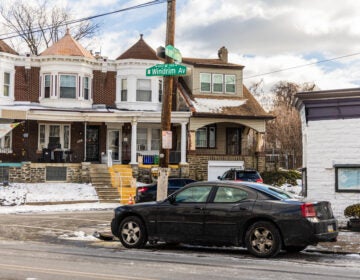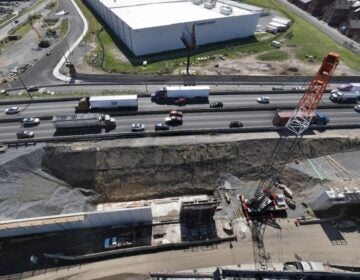Seeking refuge in pedestrian spaces on Baltimore Ave

What a difference a dozen huge, ceramic planters can make.
Midway through 2013, residents of West Philadelphia’s Cedar Park neighborhood noticed that the intersection of 48th Street and Baltimore Avenue had sprouted enormous potted plants and boulders These floral interventions allowed University City District (UCD) to reclaim some excess street space for pedestrians, establishing curb bumpouts at a discount, shortening the time it takes to cross a busy intersection.
The planters were initially met with some eye-rolling. As traffic calming tactics go, it seemed a little whimsical. But over the last three years the skeptics have been converted.
“I thought it was window dressing, maybe it looked nice but I wasn’t convinced they would achieve anything,” says Ryan Godfrey, who lives near the intersection. “But it was actually really useful to have them there. It significantly shortened the length of the crosswalks in every direction and essentially extended the safe area by several feet into the street.”
The five-way intersection where Florence Avenue sprouts off Baltimore Avenue to the southwest, is exceedingly broad. Drivers often speed unnecessarily quickly across the wide intersection, which is also a pedestrian hub.
By turning a section of the street that cars didn’t regularly use, but which they could easily swerve into, over to pedestrians the intersection became far more pleasant practically overnight. In addition to shortening the crossing distances, the project added to the communal life of the neighborhood and is a testament to the power of small changes to improve urban life.
“It really makes it easier to cross the street, especially if you have a kid who is apt to run,” says Godfrey. “My daughter is seven and she has a pretty good sense of street safety now, but a couple years ago it was more likely she’d wander off and that extra buffer really helped.”
But this summer the pots and rocks were removed from the intersection because of PennDOT’s extensive roadwork along Baltimore Avenue.
As a neighborhood resident—and an initial skeptic myself—the removal of the planters immediately made 48th and Baltimore a less pleasant locale.
In the week after the bumpouts were removed, a truck buzzed uncomfortably close to me while I stood in the former safe zone with a friend. Enjoying the conversation, I’d forgotten we had to be cognizant of danger again. Now the once-pleasant intersection, which I cross frequently to do my grocery shopping on foot, has been transformed into a hazard.
The benefit of the bumpout may have been partially psychological, but there were also measurable gains. Between 2007 and 2013, before UCD’s intervention, there were four crashes at the intersection of 48th and Baltimore. Since then there have been none.
“People love it, that’s all we’ve heard,” says Andrew Stober, University City District’s vice president of planning and economic development. “They feel a lot safer crossing the street there. And that intersection, if you’ve driven through, it wasn’t clear where to go. The lines and the pots helped clarify that for the drivers. It became a more pleasant place to drive, bike, and walk.”
University City District will return the traffic calming bumpouts to 48th and Baltimore in early November. At the same time, they will implement another road reform a block to the west and just off of the actual Cedar Park (the small sliver of greenery along Baltimore Avenue from which the neighborhood takes its name). The superfluous turning lane at the eastern end of Cedar Park, which adds unnecessary confusion to an already busy intersection, is being transformed into an extension of the park with another round of planters, plus paint, tables, and chairs.
Stober says that adding this plaza will be the rare instance of a pedestrian improvement that actually adds parking spaces to the street. Perhaps as a result, there wasn’t opposition to the lane removal voiced at any of the community meetings on the subject.
The plaza addition at Cedar Park will cost $25,000, while the process behind the initial intervention at 48th and Baltimore cost $60,000 in total for the design fee and community meetings.
Stober says University City District is always on the lookout for more traffic calming interventions, especially to tame the extra wide intersections that mar Baltimore Avenue as it slashes across the city’s grid street network. But there aren’t any others planned for the immediate future.
A good place to consider for the next intervention would be 46th and Baltimore. It’s another overly wide, chaotic tangle of an intersection, and far worse than its neighbor to the west. Six roadways converge there, creating a confusing situation for drivers, bikers, and pedestrians.
But at least one of the portals could be eliminated—the tiny nub of street where Cedar Avenue begins by peeling off Baltimore Avenue westward, and allows drivers to turn right before they reach the heart of the intersection. Bumpouts could be added to the corners of the intersection on Baltimore Avenue, making the crossing at the intersection safer for everyone.
Stober says he’s familiar with the intersection, and its dangers, but there’s been resistance to proposed pedestrian friendly reforms there in the past. As of this November residents will be able to consider the benefits of two other similar projects in their neighborhood. I think they’ll like what they see, and that they’ll want to see more of it.
WHYY is your source for fact-based, in-depth journalism and information. As a nonprofit organization, we rely on financial support from readers like you. Please give today.







